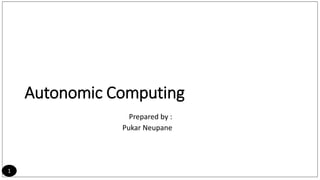
Autonomic computing.pptx
- 1. Autonomic Computing Prepared by : Pukar Neupane 1
- 2. Introduction to Autonomic Computing • Autonomic computing is a self-managing computing paradigm that aims to reduce the need for human intervention in the operation and management of computer systems. • The goal of autonomic computing is to create systems that can manage themselves automatically, in accordance with high-level objectives defined by human administrators. • The term "autonomic" is derived from the autonomic nervous system, which is a part of the human nervous system that controls involuntary bodily functions such as heart rate, breathing, and digestion. • Autonomic computing systems are designed to mimic the self-managing capabilities of the human autonomic nervous system. 2
- 3. Components of Autonomic Computing • The four main components of autonomic computing are: • Self-configuration: The ability of a system to automatically configure itself to meet changing requirements. • Self-healing: The ability of a system to automatically detect and repair problems. • Self-optimization: The ability of a system to automatically optimize its performance. • Self-protection: The ability of a system to protect itself from security threats. • These components are often implemented using a feedback loop architecture, in which the system monitors its own state, analyzes the data, and takes corrective action as needed. 3
- 4. Autonomic Computing Architecture • In an autonomic computing architecture, the basic management element is a control loop. • This acts as manager of the resource through monitoring, analysis, and actions taken on a set of predefined system policies. • These control loops, or managers, can communicate and eventually will negotiate with each other and other types of resources within and outside of the autonomic computing architecture 4
- 5. Autonomic Computing Architecture An example of a basic autonomic control loop 5
- 6. Autonomic Computing Architecture • This collects information from the system and makes decisions based on that data and then issues instructions to make adjustments to the system. An intelligent control loop can provide functionality of autonomous computing, such as the following: Requesting additional processing cycles when needed. 1. Installing software and upgrades. 2. Restarting a system after a failure. 3. Initiating backups after daily processing. 4. Shutting down systems after detection of an intrusion. 6
- 7. Autonomic Computing Architecture we see the control loop is divided into two basic sub elements: 1. The Managed Element— This can be any component in the autonomous system, such as a server, a database, or a file, or it can be numerous related larger elements, such as a cluster of servers, a complete software application, or even a business unit. This means that managed elements are highly scalable. The sensors and effectors control the managed element. 2. The Autonomic Manager— This manages the collection, filtering, and reports of the data collected from the element from the sensors. It also analyzes, models if necessary, and learns about the element, gaining knowledge. With this knowledge, it can predict future situations. The planning part provides the structure the mechanism needs for the actions it takes to achieve the desired goals and objectives of the autonomous system. The planning part also uses the predefined policies that establish the goals and objectives. These policies are described in the system. The execute part of the autonomic manager provides control of the commands being accomplished. It will establish whether the commands completed their required actions. 7
- 8. Applications of Autonomic Computing • Cloud Computing: Enable automatic scaling, load balancing, and resource management in complex cloud environments. • Network Management: Automate fault detection, capacity planning, and performance optimization. • Data Centers: Improve efficiency through automatic server consolidation, power management, and cooling optimization. • Cybersecurity: Implement self-learning algorithms and defense mechanisms that adapt to evolving threats. 8
- 9. Autonomic Computing Challenges • Developing robust self-learning algorithms • Ensuring system compatibility across different technologies • Maintaining security and privacy while enabling autonomic functions • Overcoming organizational barriers to adoption and implementation 9
- 10. Future of Autonomic Computing and Research Opportunities • Future Impact: Potential to revolutionize industries that rely on IT systems by providing more intelligent, efficient, and dynamic solutions. • Emerging Technologies: Integration with AI and machine learning for advanced self- management capabilities. • Research Opportunities: Continued exploration and development in the field to yield new innovations and methodologies to better address system performance and maintenance. 10